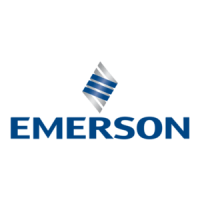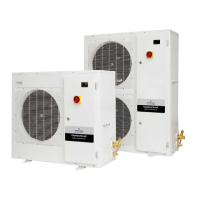
Do you have a question about the Emerson Copeland EazyCool OMQ-56-Nxx-TWD Series and is the answer not in the manual?
Explains symbols used for warnings and safety information.
Lists essential safety rules and precautions for unit operation and maintenance.
Provides general guidelines for handling, installation, and operation of Copeland EazyCool units.
Introduces EazyCool units, their application in refrigeration networks, and configuration options.
Details the information found on the unit's nameplate, including model and serial numbers.
Explains the meaning of characters in the model designation for unit identification.
Specifies qualified refrigerants, oils, and operational limits for the units.
Details the primary components of the condensing units, including compressors, fans, and sound insulation.
Describes the liquid receiver for 2-unit networks and mentions remote receivers for larger systems.
Lists the various electrical components housed within the unit's electrical box.
Details the types of pressure switches used for system protection and control.
Covers PT3 pressure transmitters and the FSP150 fan speed controller.
Describes filter driers, liquid sight glasses, and solenoid valves for the liquid line.
Explains the function of the liquid sub-cooler in low-temperature applications.
Details solenoid valves, oil separators, and electronic oil control systems.
Provides guidance on safely transporting and storing the condensing units before installation.
Presents the physical dimensions of the Copeland EazyCool™ units in millimeters.
Explains how to access the unit's electrical and refrigeration components via an access door.
Details the procedure for opening the electrical panel to access internal wiring and components.
Outlines the IP ratings and protection standards for various unit components.
Provides technical electrical specifications, including operating currents and fan data.
Illustrates the layout of suction, liquid, and oil distribution lines for the units.
Offers best practices and material recommendations for brazing refrigeration lines.
Provides step-by-step instructions for properly brazing refrigerant tubes to avoid damage.
Details installation, master/slave configurations, and piping for 2-unit networks.
Details installation, master/slave configurations, and piping for 3 & 4-unit networks.
Details installation, dimensions, and piping for 3-unit medium and low-temperature networks.
Details installation, dimensions, and piping for 4-unit medium and low-temperature networks.
Describes the procedure for configuring controllers as master and slaves in a network.
Explains the escape function for the binding process if no action is taken within 2 minutes.
Details how to remove existing network configuration links.
Explains operation in stand-alone mode during communication breakdown or controller failure.
Guides on accessing and understanding system configuration parameters.
Provides instructions on how to modify system configuration parameters.
Recommends charging the unit with refrigerant via the Rotalock service valve.
Provides information on sound pressure levels and how to calculate them for different distances.
Explains the importance of correct rotation direction for three-phase compressors.
Specifies the allowed number of compressor starts per hour.
Lists crucial checks for valves, panels, and oil levels before and during operation.
Details the steps for safely removing and replacing a compressor unit.
Confirms compliance with relevant directives like PED and low voltage standards.
Provides guidelines for environmentally responsible removal and disposal of oil, refrigerant, and compressors.











